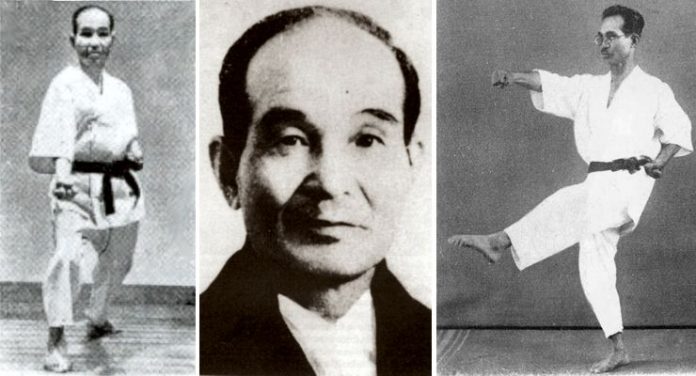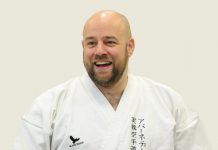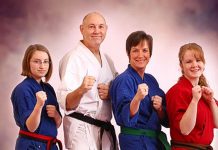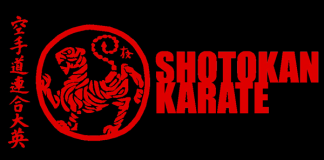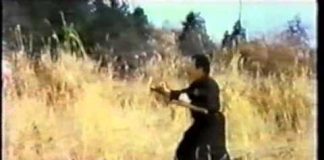With the advent of Gichin Funakoshi’s introduction of Okinawan Karate to Japan in the early 1920’s, the popularity of karate began to grow. Soon, other Okinawan masters began to travel to Japan to proliferate their arts. One such man was Kanken Toyama. Kanken Toyama was born in Shuri, Okinawa on September 24, 1888. His given name was Kanken Oyadamari and he born into to a noble family. A school teacher by profession, Toyama’s chosen avocation was the instruction of karate. He started his karate training at the age of 9 with a master named Itarashiki. His major teacher was the famous Itosu Yasutsune, with whom Toyama studied for 18 years.
In 1907 Toyama became Itosu’s assistant at Shuri dojo. Toyama became one of only two of Itosu’s students to be granted the title of “Shihanchi”, or protege, of Itosu’s O kuge (innermost secrets).
Aside from learning Shorin-ryu from Itosu, Toyama studied and mastered their styles of karate from other notable masters of Naha-te and Tomari-te, which included weapons arts. A few of his other teachers were, Aragaki, Azato. Chibana, Higaonna, Oshiro, and Tana. Toyama’s interest in martial arts was not limited to karate. He was considered an expert swordsman, as well. While on a six year assignment to teach elementary school in Japanese occupied Taiwan (1924-1930), he studied Chinese martial arts with masters Chen Fong Tai in Taipei and Lim Fun Fong in Taichung.
Given this diverse martial arts background, the Japanese government soon recognized Toyama’s prowess, and awarded him the right to promote to any rank in any style of Okinawan karate. An official gave Toyama the title of master instructor. Toyama’s first dojo was opened in Tokyo in 1930, and he quickly became famous for his Aka Ryoku (strong gripping methods of Itosu and Itarashiki).
The name of Toyama’s school was Shudokan, which means “Institute for the cultivation of the way.” Today, this term refers not only to his school, but also to his system. Shudokan karate is a composite system, encompassing Kobutjutsu (Ancient art, referring to the specialized weapons practice of Okinawan karate). There are also kata (formal exercises) that are unique to Shudokan karate. Shurite, sometimes known as Shorin-ryu, or Itosu-ha is a component of Shudokan karate. Its kata represent light, quick motions and a variety of power sources.
The Naha-te system’s forms, sometimes known as Goju-ryu, Shorie-ryu, or Higashiona-ha, represent strong rooted motions with an emphasis on internal breathing. Power sources include both hard, and soft. The Tomari-te style is generally considered an extinct system except in a few composite systems such as Shudokan.
Tomari-te is characterized by the speed of the Shorin-ryu and the strength of the Naha-te, and also included its own soft type of power. Tomari-te included some tight yet sophisticated motions; and in appearance it is both graceful and noble.
The aspect of weapons in Shudokan adds to its versatility and practicality. Weapons have also affected the empty hand forms in that the motions tend to be larger, often drawing a number of intersecting circles, with different parts of the body moving on different planes at the same time.
Shudokan is characterized by large circular motions with an emphasis on covering. The practice of extension of the motions develops power and physique. Soft power is taught along with sophisticated applications. which included throws, blocks, and chokes. Because of the balance between hard and soft power, this system promotes good heath.
Shudokan, because of its physical character, has developed its own unique kata. One set of forms that were developed within the system is the Kyoku forms. There are seven kata in this group,. starting with the very basic techniques, and building into long complex form, in a set progression. Originally taught only at the Hombu Dojo (Headquarters School), even the most basic of these kata were reserved for members who held a third degree black belt or higher. These forms were developed to represent the fighting techniques of the system and were considered secret. Today, the basic Kyoku forms are taught only to brown belt student, and the longer more complex forms are still taught only to black belts.
Another unique set of forms created by Shudokan are; Sonshin, Kakashin, and Choshin. These forms are used to develop and concentrate the potential of an individual.
As an educator, Toyama believed his system should not stagnate. This intention was built into the system to allow for its continued growth of both the individual and style.
This account is edited information that has been provided by Shihan Walter Todd (the American Shudokan Association), and the East Asian Cultural Institute.


